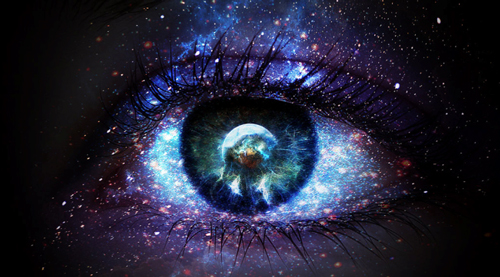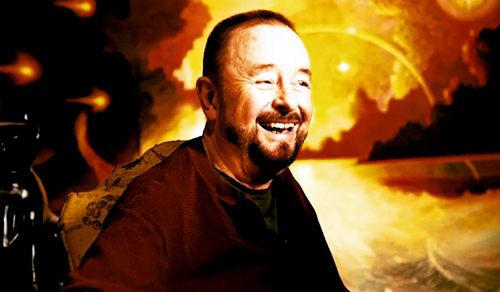Sight beyond sight: the remote viewing phenomenon
The psychic discipline of remote viewing has allowed researchers the opportunity to go beyond the fringes of time and space to previously unexplored regions of our solar system. The conscience can go where the body cannot, and with training and purpose it has proved to do just that.

Remember that the human brain takes in about forty million bits of information per second but only sixteen bits of that actually goes into your conscious mind – with the rest finding its way into our subconscious, it is clear that we only perceive a fraction of what we consider ‘reality’ during waking hours of full consciousness.
Remote viewing (RV) is a method used to tap into the subconscious mind in the right side of the brain in order to reveal previously uncovered information. The viewer can go beyond the individual’s mind capacity and reach further into the unknown to perceive things which exist physically beyond the immediate influence of the viewer.
RV is a trained ability which allows the viewer to acquire accurate direct knowledge unavailable to the ordinary senses, of events or ‘targets’ which are distant in time or space, in either the past, present or future. In the words of the leading researchers in the field, Russell Targ and Dr. Harold E. Puthoff, “Remote viewing is a human perceptual ability to access, by mental means alone, information blocked from normal perception by distance, shielding, or time.”
The information is retrieved under specific scientific protocols and then recorded and filed in a report for further analysis. Such psychic practices became useful military applications which were utilised in a number of ways to enable the viewer to perceive targets in (amongst other things) top secret facilities around the world, as a means to spy on the enemy undetected.
The ability to see beyond one’s range of vision may be used for different purposes in modern times and for completely different reasons, but the use of such psychic skills is by no means a new endeavour. As remote viewer Courtney Brown wrote in his book Cosmic Explorers, “…the ancient seers were our first human astronauts. While in a deeply relaxed state, they let their minds roam across the fabric of the universe, and some perceived what was there with surprising accuracy.” Brown believes that it is the genetics of our human bodies that limits our perceptual abilities and that remote viewing as a process actually helps to alleviate such limitations.
Joe McMoneagle, who was known in the US Army’s psychic intelligence unit at Fort Meade in Maryland as “Remote Viewer No. 1” (he was the original member of a top secret program on the subject codenamed the Stargate Project) explained the meaning of the term: “Remote viewing is the ability to produce information that is correct about a place, event, person, object or concept which is located somewhere else in time and space, and which is completely blind to the remote viewer and others taking part in the process of collecting the information.” Ultimately, the art of sight beyond sight was the main skill employed by the U.S. military’s psychic spies from the 1970s onwards.
American psychic and artist Ingo Swann was probably the most innovative and influential remote viewer to have succeeded in this most unusual field of parapsychology. Swann described remote viewing as being “… composed of a five part protocol, and when any one of the five parts are omitted (such as confirmatory feedback), then what has taken place is something other than remote viewing…” Continuing, he added: “If these important definitional boundaries are not understood and maintained, the ultimate result will be ambiguous definitional quagmire of benefit to no one, and the demolition of what the remote viewing protocol achieved in terms of respect and repute.”
Realising the potential to view targets much further away than had previously been considered possible, Swann proposed a larger experiment, to describe the weather in a different city, then calling someone at that location to confirm the accuracy. The term ‘remote viewing’ originated, as the cities they were attempting to view were remote from New York. Because back in the seventies there was no internet or any other immediate means of Swann knowing the weather elsewhere whilst isolated in his room, the initial experiments proved to be successful. He managed to accurately describe ‘seeing’ rain in Arizona when it hadn’t rained for months; this most definitely was not guesswork.

This work led to his involvement at SRI, working on his first CIA funded project which was headed by physicist Dr. H. E. Puthoff. The U.S. had become aware that the Soviets were roughly 25 years ahead in Psi research, and it was because of the Americans’ desire to catch them up that ultimately allowed Ingo Swann to make a living from his psychic abilities.
The initial project was set up to explore ways of reproducing ESP phenomena at will, something which Swann was more than adept at already. The project was given eight months to produce some results but Swann became bored of the same repetitive processes involved in the daily experimental trials so he suggested maybe trying something a bit more adventurous and exciting to relieve the monotony.
NASA had recently launched two probes, Pioneer 10 and 11 to flyby the planet Jupiter, and the data which would be collected was to become available from September, 1973. It was in April of the same year that Swann suggested remote viewing Jupiter before any information had been received, as it could easily be verified or dismissed once the signals returned to Earth. He was essentially aiming to psychically ‘arrive’ on Jupiter before the NASA vehicles did physically.
Once his superiors had reluctantly agreed, the experiment was done on a Saturday, a non-working day, on Swann’s own personal time. Initially the VLD (very-long-distance) experiment was done unofficially but it was still considered a necessity for the RV raw data to be recorded in order to establish that it had existed prior to the arrival of the Pioneer probes. Many respected scientists in the Silicon Valley area including two from Jet Propulsion Laboratories, agreed to receive copies of Swann’s raw data which finally consisted of two and a half pages of verbal observations and one page of sketches. In order for the experiment to be successful it was deemed essential to include impressions of factors regarding Jupiter which were previously unknown to man.
The raw data which Swann produced during April 1973 yielded thirteen “scientifically unanticipated” factors which were eventually confirmed to be accurate at a later date, once the incoming NASA data had been analysed. Below are the raw data factors on Jupiter which Swann recorded, along with the dates they were eventually confirmed:
1. The existence of a hydrogen mantle: Confirmed 1973, and again in 1975.
2. Storms, wind: Confirmed 1976 as to dimensions and unexpected intensities.
3. Something like a tornado: Confirmed 1976 as strong rotating cyclones.
4. High infrared reading: Confirmed 1974.
5. Temperature inversion: Confirmed 1975.
6. Cloud colour and configuration: Confirmed 1979.
7. Dominant orange colour: Confirmed 1979.
8. Water/ice crystals in atmosphere: Confirmed 1975.
9. Crystal bands reflect radio probes: Confirmed 1975.
10. Magnetic and electromagnetic auroras (“rainbows”): Confirmed 1975.
11. A planetary ring inside the atmosphere: Confirmed 1979, not only as to its existence, but as being inside the crystallised atmospheric layers.
12. Liquid composition: Confirmed 1973, 1976, as hydrogen in liquid form.
13. Mountains and solid core: Still questionable, but suspected as of 1991.
The majority of scientists had denounced the possibility of Jupiter containing a ring until it was confirmed in 1979, despite the fact that Ingo Swann had sketched it in his raw data back in 1973. It was this information which Swann produced that really brought him to the attention of some very secretive members from within the higher echelons of society not to mention the American government. As Swann recalled, “Among those taking an active interest in the possibility of interplanetary spying was a group so clandestine that it would be characterized not merely as a deepest black project, but as an entirely invisible one.”
Swann was the first man in modern times to seriously attempt psychic astronautics and follow his desire to push the perceptual boundaries beyond previously considered unreachable locations. As his Jupiter data confirmed, the ability to see beyond the physical capabilities of human vision is a very real phenomenon, one which still remains a mystery today.
yogaesoteric
January 19, 2020
